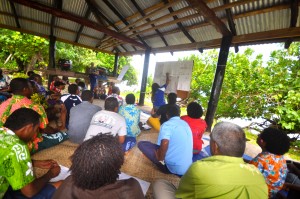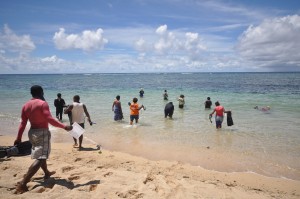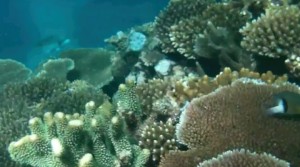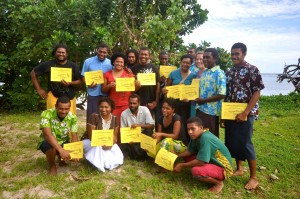March 2, 2013
Locals Put their MPA Monitoring Skills to Practice
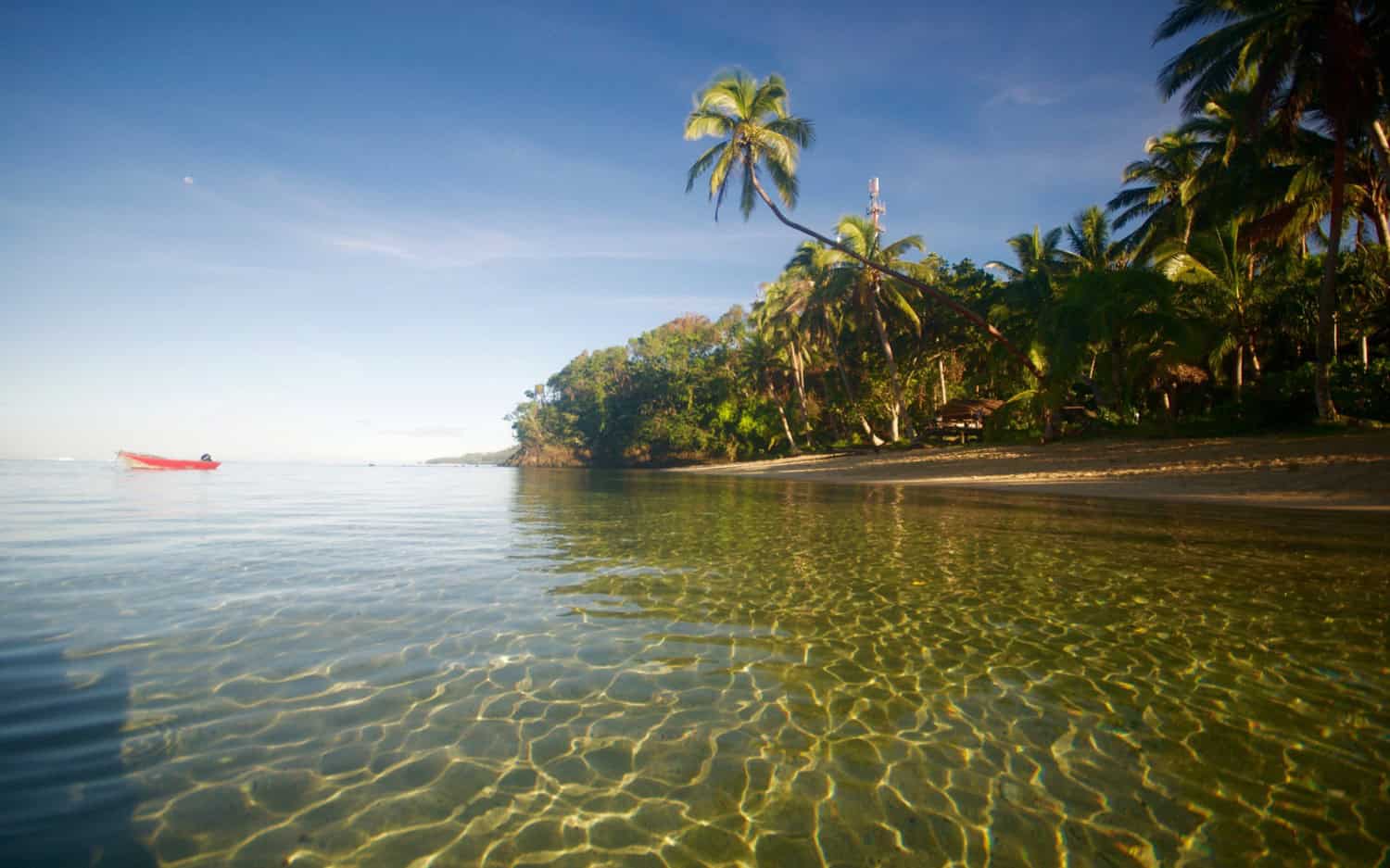
Written by Kirsty Barnby
Locals Put their MPA Monitoring Skills to Practice
Between 11-18 February, Fiji’s longest established MPA, Waitabu Marine Park, Taveuni, played host to a group of dedicated local marine lovers who came together to take part in their annual marine survey.
This year was particularly special for the communities of Waitabu, Lavena, Wai, Vurevure and Bouma because they were keen to find out how the new, seven-month-old tabu-tara area directly outside their village, was affecting fish numbers and coral growth.
The week of marine activities included:
- Large scale habitat and invertebrate species: The manta tow monitoring method is used for assessing broad-scale changes in reef cover due to cyclone damage, coral bleaching and outbreaks of the Crown-of-Thorns starfish.
- Fine scale invertebrate surveys: Timed search and measurements.
- Fine scale reef populations: Reef Check’ point and belt transects: A randomised technique to measure what is on a reef in a small area, we can then compare to other reefs around the globe.
- Fish populations: Underwater visual census for indicator species.
A summary of the survey results for 2012 and 2013 are as follows:
|
2012 (1-7 March for tabu and tara areas)
|
2013 (11-18 February for tabu and the new 7 month old tabu-tara) |
| Beach de Mer (Sea Cucumber): Despite the challenges of poaching over the last few months, (which has now been addressed by the local police) Sea Cucumbers have doubled in quantity from last year to 107 in the tabu area this year.
|
Beach de Mer (Sea Cucumber): A healthy increase from 107 to 176 Beach de Mer were recorded in the tabu area this year. Baby Beach de Mer are breeding in the tabu area and as a result, juveniles are being seen in the tabu-tara for the first time. 156 were recorded in the tabu-tara area. |
| Seaweed Levels:Large schools of fish in the tabu area have eaten the seaweed and created clean rocks for new corals to grow, providing more places for small fish and other animals to live. There is a distinct difference in colour from the tabu areas which is brightly coloured with healthy coral to the tara area which is green from the extensive seaweed coverage. | Seaweed Levels:For the first time ever levels of coral have increased and seaweed levels are decreasing in the tabu-tara area. Due to the increase in coral, 300 Ika loa lailai (small surgeon fish) were noted in the tabu-tara. They feed on seaweed which in turn aids coral growth.
|
| Bula (Crown-of-Thorns):Again in the tabu area, the Crown-of-Thorns have almost increased ten-fold from 5 last year to 43 this year. With consent from the Waitabu Marine Park Committee, the group responded directly by clearing 100 of these starfish in just one hour. | Bula (Crown-of-Thorns):The bula count in the tabu area more than doubled from last year. A total of 91 were recorded. Four of these were in the tabu-tara. |
| Vivili (Trochus Shell):Vivili sightings were high in the tabu area and low in the tara area. They have also grown to breeding sizes. | Vivili (Trochus Shell):Vivili have continued breeding towards the shore. 39 were recorded in the tabu area and two in the tabu-tara. |
| Living Coral:Living coral levels have been notably higher in the tabu area than the Tara area consistently since 2006.
|
Living Coral:Since the introduction of the tabutara just seven months ago, there has been a five fold increase in the living coral count in the tabutara area. It is the first time ever that the levels of the coral have increased. |
| Vasua (Giant Clam):62 giant clam were found in the tabu area which shows a continuing up swing on clam numbers and size. The largest was 56cm. | Vasua (Giant Clam):In total 75 vasua were counted this year, the largest being 80cm in size. Small giant clam are being spotted in the tabu-tara for the first time. |
| Cawaki (Urchin):Numbers of Cawaki are increasing in the tara area in front of Waitabu Village while none were spotted in the tabu area just metres away. This demonstrates how the lack of certain species can help with understanding the state of the reef. In this case, the high numbers of Cawaki in the tara area point towards there being fewer predators such as triggerfish. | Cawaki (Urchin):Following the same trend as last year for the same reasons,108 cawaki were seen in the tabu-tara and 3 in the tabu area. We expect to see fewer in the tabu-tara as fish numbers increase over the next few years. |
Conclusion
- The tabu is restocking the tabu-tara area.
- The spill-over effect from tabu to tabu-tara is evident from this locally based research.
- Fish sizes and counts are expected to increase in the coming months.
Waitabu Marine Park has long since been a pioneering example of a successful locally managed Marine Protected Area (MPA). The communities of Waitabu and Bouma came together to protect their native fishing grounds back in 1998. Their foresight and diligence allows visitors the opportunity to share in the beauty of the Waitabu Marine Park.
If you would like to book a trip or learn more about the MPA or monitoring methods used, please contact:
http://waitabumarinepark.blogspot.com
To book call: 679-820-1999
